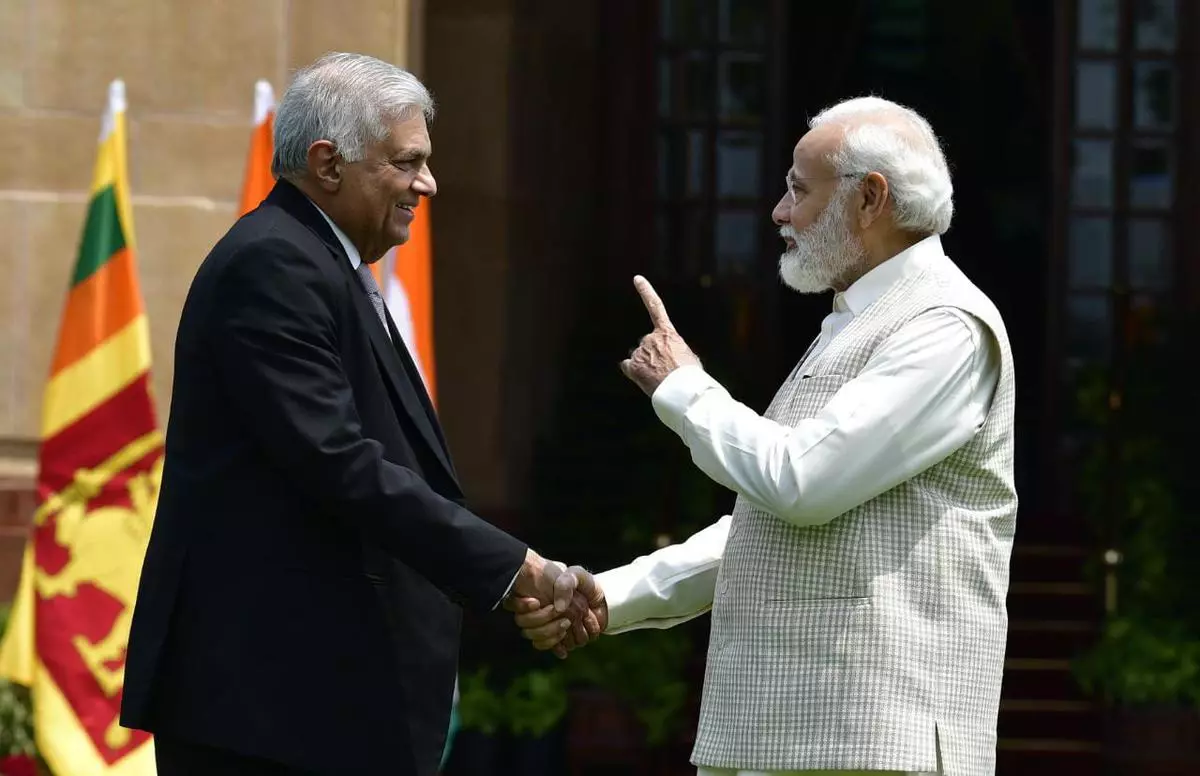
PM Modi with Sri Lankan President Ranil Wickremesinghe
India’s less dramatic definition has been presented as its “neighbourhood first” strategy, and the US-led Western world has visibly agreed to support India’s premium posture in the subcontinent. The World Bank refers to this initiative as #OneSouthAsia.
Welcome to a newly emerging regional system, supported by the world’s fifth-largest economy.
Nowhere is this more clear than in Sri Lanka, where private enterprise such as the Adani Group or, HCL or budget airlines Indigo and SpiceJet are riding on India’s massive power projection across the island nation — that is manifesting in the creation of an energy hub in eastern Trincomalee, in the development of hybrid power projects in islands off Jaffna in the north, while Colombo agrees to share exclusive space in its port terminal in the capital.
Let’s be clear. This leveraging of a country’s national power by private capital is not a new idea. What is new is that the idea has expanded enormously from the corridors of power in South Block and North Block in Delhi and caught root in large parts of South Asia. Everyone understands that the Adani Group, for example, may not have as easily won the bid for developing the west container terminal in Colombo’s port – in partnership with Sri Lanka’s largest private and highly respected company, the John Keells group – or solar farms in Mannar and Pooneryn, if the Narendra Modi government had not, allegedly, nodded in its favour.
Or that the unelected President Ranil Wickremesinghe, who is often seen as a cat’s paw for the still-powerful and pro-China Rajapaksas, had not, allegedly, agreed to a lip-teeth partnership (the Chinese phrase, “chun wang chi han” literally means that the teeth feel cold without lips), when he saw the Indian readiness to bail out his economically devastated nation last year. (India has so far given $4 billion in aid and credit lines.)
Two other facts are apparent after travelling through paradise for a full week — not including the special feeling that comes from the Indian Ocean washing your feet in Mannar, or eating a five hopper-fish curry lunch in an amazingly clean dhaba in Nalanda Gedige for only Rs 150 and travelling on a third-class train ticket from Kandy to Colombo as the countryside unspools in front of you.
First, the SAARC regional grouping launched in Dhaka in 1985 – a mouthful known as the South Asian Association for Regional Cooperation – is comatose, if not dead. Equally, SAARC can only be revived if India is interested, because it is only the Indian economy that can inject the desperately-needed cash into the regional bloodstream. (The World Bank and the ADB would happily fund the revival, but only if India gives the green signal.)
For now, though, the Modi government has decided it will do as much as it can to weaken Pakistan – save a cricket match or two at the Narendra Modi stadium in Ahmedabad – and at the same time, try and integrate the other nations into its own economy. Sri Lanka, Nepal, and Bangladesh are on top of that list.
Clearly, a historical moment is at hand and Modi, as he winds down his second term in power in Delhi, seems to have grasped it. Modi is also smart enough to realise that the knotty political problems in each of these countries have to be smoothened out – in Sri Lanka it is the refusal of the Sinhala elite, as manifested in Wickremesinghe’s indifference to implementing the 13th Amendment in the Constitution that gives equal rights to the Tamil minority – if the profit-making has to be taken to its logical conclusion.
This means that Modi is willing to accept Wickremesinghe’s empty promises on the 13th Amendment, because he knows the unelected Sri Lankan politician is his best bet in letting Indian business expand their footprint in the island.The Sri Lankan private sector is equally amenable to deepening ties. Connectivity is the name of the game. It’s a perfect win-win for both sides.
Consider how much has changed since the 1987 India-Sri Lanka Accord, when Indian troops were deployed to Sri Lanka to maintain the peace. The transformation of Trincomalee was a component of the Accord, to be fair. The initial measures toward spanning the Palk Straits are now being taken, forty years and a civil war later.
That is why Wickremesinghe’s recent trip to India, despite the fact that it was only for 27 hours, was so crucial. It reaffirmed the idea of the Trincomalee energy center and announced a set of connectivity measures for all socioeconomic levels, including ferry services for the underprivileged, air services for the wealthy, and possibly a road causeway for both.

















